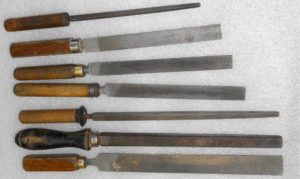
During the operation of the file, its ability to process various materials gradually decreases. There are only two reasons:
- notches are erased / dulled
- the space between the notches is filled with metal dust (waste of the treated surface).
How to restore notches on a file?
There are several ways, but most of them are not suitable for home use. We will not analyze the technology in detail - it is unlikely that anyone will bother. But “in a nutshell” I will still describe the process:
The file is heated to a temperature of 750 degrees Celsius, after which it slowly cools down in air. This procedure (vacation) significantly reduces the hardness of the metal from which the file is made. After that, the surface of the file is milled, polished and new notches are made on a special machine. Finally, the file is hardened so that it regains its required hardness.
How to clean a file?
When the space between the notches is filled with waste material, even sharp notches are no longer able to process the surface of the part. Most often, notches are clogged when processing copper, aluminum, stainless steel. In fact, the height of the cuts is reduced and the file becomes “smooth”.
Cleaning the file from metal dust can largely restore the file to its original properties.
The easiest and most effective way to restore the surface of a file is chemical. Let's stop on it.
File preparation.
First of all, the file must be cleaned of dirt with a metal brush. First "dry", and then with the use of cleaning products or washing powder. This procedure is also needed to remove fatty deposits.
The final stage of degreasing is treatment with acetone (if there is no acetone, you can take a nail polish remover).
All! The file is ready for etching with a special solution.
Etching
Now the file must be dipped in one of the solutions below. There are several compositions. The most popular, I'll tell you:
The composition of the first solution is the most aggressive. It works quickly, but you need to be extremely careful and observe safety precautions when working with acids. The composition includes the following components:
– Water – 85%
– Nitric acid – 9%
– Sulfuric acid – 6%
The file is placed in a container with this solution for 2-3 hours.
You can use less aggressive household chemicals:
- sewer pipe cleaner (6 hours),
- acetic or citric acid (12-16 hours),
- aqueous solution of ferric chloride in the ratio 1:4 (1.5 hours)
Completion
After being in acid, the file should be washed in an aqueous solution of soda (2 tablespoons per 0.5 l of water) for 2-3 minutes. This procedure is needed to neutralize the acid remaining on the surface of the metal.
The washed file must be protected from rust formation. To do this, it is placed for 10 minutes in a solution: laundry soap (5 grams) and sodium nitrate (1 gram) per 1 liter of water.
A dried file can be used again, almost like a new one.